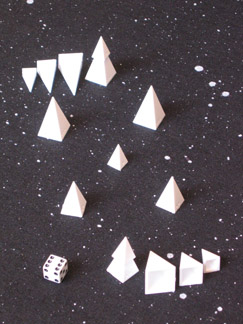 StarRunners
StarRunners StarRunners
StarRunnersBy Andrew Looney, 1/13/5
Concept: You control a small fleet of spaceships, as does your opponent. Your task is simple: you must maneuver your fleet across the galaxy to your opponent's star system. Along the way, all of your ships must stop at a difficult-to-reach system called Backwater. It's a friendly race, so you can't actually attack the other player, but there are ways you can try to slow them down. Who will get there first?
Background: StarRunners is based on Homeworlds, an epic space-conquest game that requires a full 4-color Icehouse set. StarRunners is a much simpler and shorter game, played using just 1 stash of pyramids (plus a six-sided die). StarRunners employs many basic Homeworlds concepts & mechanics, and as such is a great game to start with before learning Homeworlds itself.
Equipment: You need a stash of Icehouse pieces and a 6-sided die. White, clear, purple, or some other non-standard color is suggested. If a standard color must be used, Blue is recommended, since Red, Yellow, and Green have more specific meanings in Homeworlds.
Homeworlds Basics: Upright pyramids are star systems. Homeworlds are binary systems, which are two pyramids together. Pieces lying down and pointing away from you are your starships. You can only move a ship from one system to another if the two systems have no pyramids of the same size.
Setup: Each player builds a binary system (unmatching), and parks a fleet of 3 ships (small, medium, and large) at this system. The remaining 5 pyramids are arranged as stars between these two Homeworlds. Also, determine who goes first (preferably by flipping a coin, but with the die if needed).
Goal: The object of the game is to move your whole fleet of ships from the Homeworld you start at to the Homeworld your opponent is parked at now. On your way, all of your ships must visit Backwater, this being the one star system in the middle, which neither player can get to easily. Each ship must end a turn stopped at the Backwater system.
How to Play: On your turn, roll the die. It takes 1 pip on the die to move 1 pip's worth of your ships. Thus, a roll of 1 will only allow you to move your small from one system to the next. A roll of 6 would let you move each of your ships once. You could also move the large twice, or the medium 3 times.
Conflict: There is no combat nor any catastrophes in this game. However, strength still has its power. Larger ships may block smaller ships, both from entering and exiting a star system. No ship may enter a system if it is occupied by an enemy ship of a larger size, and no ship may leave such a system either. (The latter is calling pinning.) Exception: A ship cannot be pinned at a Homeworld.
Winning: Whoever first gets all 3 of their ships to their target Homeworld after tagging Backwater wins the game!
More About Homeworlds: It's important to realize that
this game only borrows certain concepts from Homeworlds. In that
game, movement is done not with dice but based on availability
of yellow pieces. Larger ships cannot block arrivals or delay
departures as they can in this game, but if they have access to
the power of red pieces, they can board and take control of enemy
ships. In Homeworlds, empty star systems are removed from the
board but new systems can be added to the star map any time you
want. And in that game, the object is not a simple race, but a
complex struggle for existence itself. But while the two games
are very different in many ways, the system of arranging pieces
as ships or star systems and the way in which those star systems
are connected are the same, thus StarRunners provides a good taste
of Homeworlds, but with just one stash and a much easier learning
curve.